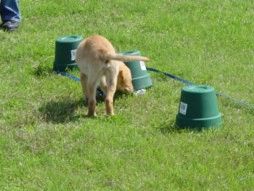
First, make sure the basics are done before spending too much time in searching. If your dog does not show pronounced desire to possess the reward object, you should not be hiding the object in areas where the dog cannot get directly to the reward.
Second, the “pot” test is a TEST given at set intervals. It is not a TEST the dog studies or prepares for directly. It serves two purposes – to judge how the dog is progressing in training and to assess the dog’s attributes as they are linked to genetic influence. NO ONE uses this test for procurement purposes. The only time the dog should be performing this test is at the set intervals and at no other time.
Third, the PVC cone training is TRAINING. It will work to provide the young pup the opportunity to develop specific skills. Sniffing is a learned behavior that can easily be rewarded in this style of training. Additionally, you can work with height and depth problems in a very basic way. We should be using these exercises with a young dog. As the dog develops higher possession skills as an adult dog, we will transition away from food reward in the PVC cone training toward looking for reward in more realistic settings.
Dog training does not lend itself well to formulaic or linear progressions in training. The variations in adapting your training are as numerous as are the ages of the dogs, the breeds of the dogs, the environments where the dogs live, and the knowledge and experience of the person working with the dog. When the “Horse Whisperer” was popular, I was fond of saying dogs don’t whisper- they scream! You must adapt to the individual dog, by looking at the dog critically and adapting the training and exposure to the dog’s needs.
Past blog entry-
The Problem with Training Plans
March 19, 2019
Under 6 month priorities
- Environmental Stability
- Socialization
- Reward Engagement
- Search
- Olfactory Acuity
Approaching 1 year priorities
- Olfactory Acuity
- Search
- Reward Engagement
- Socialization
- Environmental Stability

